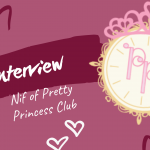Colour Balance in a Coord
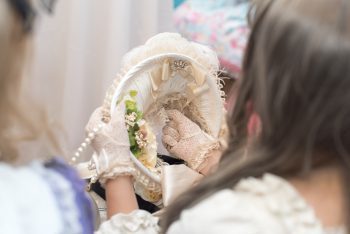
People often wish that their life were easier. And as much as we hate maths, sometimes we long for a formula to simplify things further. The best Lolita coordinates tend to come from those experienced in the intricacies and subtleties of coording and balancing colours. But can years of experience and hundreds of outfits be condensed into a colour balance formula for others to use? Let’s find out!
Deconstruct the Coord
We must start with the basics and look at the building blocks of a Lolita coord. A typical one would consist of, going top to bottom: headwear, a blouse, a main piece, legwear and shoes. When thinking about colour balance, break the coord down into another four sections: head, top body (including arms), lower body (from waist to knee) and legs. The easiest way to ensure colour balance is to have each colour in all four sections – but that’s too easy. So here’s how this works in practice.
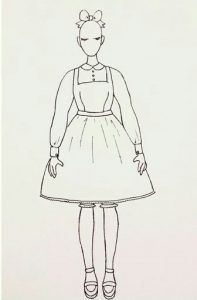
Basic Lolita coord. Image by for2buns, thank you for contributing your artwork!
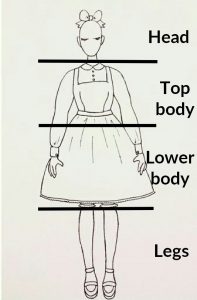
The four parts of a Lolita coord. Image by for2buns, you can find her on Instagram!
Colour Balance for Duotone
Sticking with two colours is a great and simple way of achieving colour balance without much effort. Think of the main piece you want to use – this will be your main colour. For the second use either a neutral base colour (white for Sweet, ivory for Classic or black for Gothic Lolita), an accent colour from the print or a complimenting shade for non-printed dresses. Now spread them across the four parts, trying to keep the chunks of main colour separated by the second colour. A simple formula would have your dress, headwear and shoes in one colour and the blouse and legwear – the other. This method distributes the colours evenly across the body and works even if the shades aren’t a perfect match by creating separation zones, tricking the eye into thinking that the colours match after all.
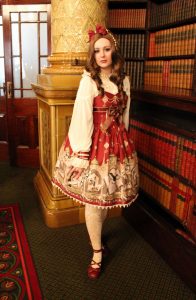
Colour balance with red and ivory using this formula. Both colours are evenly distributed across all four parts of the coord.
Colour Balance for Tricolour
With the above formula as our base, where do we add the third colour? While it’s possible to find two-tone blouses and legwear, they aren’t common. The simplest way is to keep the base and add accessories in the third colour across the coord. Printed dresses will be easier to work with as they already have a few colours in the print. For non-printed dresses think of further complimenting shades that will work with the two you already have. Smaller pieces are easier to incorporate: a hair clip, some rings, a brooch and socks featuring two colours. But it could also be a cardigan, an underskirt, a wig and a handbag. Consider the look you’re trying to achieve and what pieces you’re able to use to determine what will work best. As long as there are pops of all three colours across the whole coord, you should maintain colour balance.
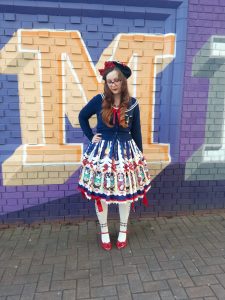
A classic red, white and blue tricolour coord. These feature on the dress, the beret, the cardigan and the legs through socks and shoes.
Colour Balance for a Rainbow
In theory, you could keep adding accessories in a fourth colour, fifth and so on and still maintain colour balance. However, in practice this would only work for OTT Sweet Lolita and even that at a push. Yes, even OTT Sweet Lolitas tend to stick to a maximum of three colours. Think of colour balancing as juggling: the fewer the balls the easier it is to juggle. As the overall aim is to create colour balance in a coord, sticking to one or two is enough. Any more and your coord could end up chaotic – too chaotic to balance. While you’d probably get away with an extra small ring or hair clip, since any additional colour isn’t playing a major part in the coord, you don’t need to worry about distributing it evenly.

Sometimes even a rainbow is too much.
Final Tips
Even the most useful formula is only a guideline. Once you are comfortable with putting together balanced outfits, have some fun experimenting. See how you could retain colour balance in an outfit without a blouse. Or try applying that formula to themes or patterns instead of (or alongside) colours. You won’t learn if you only ever stick to the safe option. Which means you probably won’t create a stunningly original coord to win the next Alice Holic coord competition.
* Featured image by Emily Valentine Photography.
She/her.
29-year-old Capricorn, Polish-born, UK-based and in love with Japanese fashion (predominantly Lolita). I enjoy a good bargain, OTT coords, cats and baking, and when in Japan I’m a self-confessed purikura addict. When I don’t blog, I work in the education sector, overseeing international exchange programs, and sometimes I get to do some exciting freelance translations on the side.







